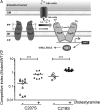Bile salt-induced intermolecular disulfide bond formation activates Vibrio cholerae virulence
- PMID: 23341592
- PMCID: PMC3568309
- DOI: 10.1073/pnas.1218039110
Bile salt-induced intermolecular disulfide bond formation activates Vibrio cholerae virulence
Abstract
To be successful pathogens, bacteria must often restrict the expression of virulence genes to host environments. This requires a physical or chemical marker of the host environment as well as a cognate bacterial system for sensing the presence of a host to appropriately time the activation of virulence. However, there have been remarkably few such signal-sensor pairs identified, and the molecular mechanisms for host-sensing are virtually unknown. By directly applying a reporter strain of Vibrio cholerae, the causative agent of cholera, to a thin layer chromatography (TLC) plate containing mouse intestinal extracts, we found two host signals that activate virulence gene transcription. One of these was revealed to be the bile salt taurocholate. We then show that a set of bile salts cause dimerization of the transmembrane transcription factor TcpP by inducing intermolecular disulfide bonds between cysteine (C)-207 residues in its periplasmic domain. Various genetic and biochemical analyses led us to propose a model in which the other cysteine in the periplasmic domain, C218, forms an inhibitory intramolecular disulfide bond with C207 that must be isomerized to form the active C207-C207 intermolecular bond. We then found bile salt-dependent effects of these cysteine mutations on survival in vivo, correlating to our in vitro model. Our results are a demonstration of a mechanism for direct activation of the V. cholerae virulence cascade by a host signal molecule. They further provide a paradigm for recognition of the host environment in pathogenic bacteria through periplasmic cysteine oxidation.
Conflict of interest statement
The authors declare no conflict of interest.
Figures




References
-
- Miller VL, Taylor RK, Mekalanos JJ. Cholera toxin transcriptional activator toxR is a transmembrane DNA binding protein. Cell. 1987;48(2):271–279. - PubMed
-
- Krukonis ES, DiRita VJ. From motility to virulence: Sensing and responding to environmental signals in Vibrio cholerae. Curr Opin Microbiol. 2003;6(2):186–190. - PubMed
-
- Skorupski K, Taylor RK. Control of the ToxR virulence regulon in Vibrio cholerae by environmental stimuli. Mol Microbiol. 1997;25(6):1003–1009. - PubMed
Publication types
MeSH terms
Substances
Grants and funding
LinkOut - more resources
Full Text Sources
Other Literature Sources
Molecular Biology Databases

